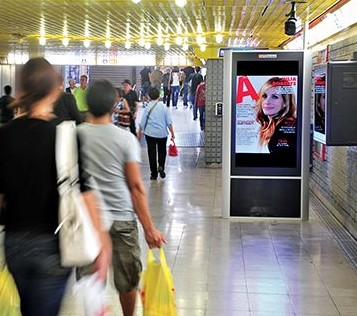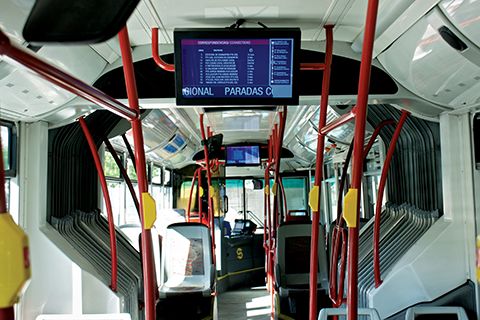Digital Signage: Transforming travel
For the airport employees who need to manage these digital signage networks, there are many options today that make it easy to approve, upload and broadcast content online, either to the entire terminal-wide system or to targeted zones with focused messages. In China, for example, Shanghai’s Pudong and Hongqiao International Airports have implemented software allowing staff to broadcast eight content channels from a single personal computer (PC), so only one content manager is needed to monitor the system.
Moreover, the digital out-of-home (DOOH) advertising system used at these two airports enables synchronized playback, so images can move from screen to screen as people walk past them. More than 250 concurrent, targeted and synchronized content channels are available to any of the more than 200 displays in both airports, at any size, resolution or configuration. This setup allows ads to be extremely dynamic and engaging, yet keeps management simple.

Indeed, airports have been among the most successful venues in terms of generating sufficient DOOH advertising revenue to make their digital signage networks nearly self-sustaining (see Sign Media Canada, September 2014, page 46). Their terminals present a strong, high-visibility opportunity for advertisers to reach a broad audience.
In Turkey, for example, six high-definition (HD) video walls at four airports—including Istanbul Ataturk Airport’s international terminal and Bodrum Airport’s, Izmir Adnan Menderes Airport’s and Dalaman Airport’s domestic terminals—have successfully attracted advertisers because they are seen by roughly 60 million people every year. Fashion companies, banks and government ministries are among the advertisers that upload ads to the video walls and more than 100 other screens in the airports via the web.
Public transit
Airports are certainly not the only transportation venues that have used digital signage to improve efficiency
of communications and increase travellers’ comfort, but they have helped lead the way. In Milan, Italy, for example, a network of about 40 liquid crystal display (LCD) ‘totems’ at the city’s airports was so well-received for providing a positive service, staff at other transportation centres in the region began to take notice.
Soon, local officials decided to install similar displays in the city’s subway system. Their project saw 67 vertical (portrait-mode) LCD totems providing route information, delay notifications, public messages and ads.
Meanwhile, in Madrid, Spain, the main form of transportation for thousands of commuters and tourists is city buses, operated by EMT Madrid. With an increased awareness of digital signage, EMT administrators saw an opportunity for a pilot project to improve ease of travel, which can be challenging given the city’s many winding streets.

The pilot involved 35 buses to test the effectiveness of the medium. Each bus was equipped with three screens in different seating zones, so content would be visible to all passengers. Then, in addition to displaying the buses’ timetables, weather forecasts, cultural event announcements and ads, the signs featured a map showing each bus’s current location—based on Global Positioning System (GPS) data—and information about other connecting bus lines. In this way, the screens would always be relevant with real-time content.
To further assist visitors, the signs also presented information about tourist attractions specific to each upcoming bus stop along the route. And all content was displayed in both Spanish and English.
Ubiquitous and diverse
In these ways, digital signage
is transforming the way people travel, all around the world.
By offering a single solution
to complicated, multi-faceted issues in chaotic, fast-paced settings, the medium has become perceived less as an amenity and more as a necessity. As such, more and more transportation organizations have invested in digital signage—and their numbers will only continue to increase.
At the same time, there seems to be no end to creativity and variety in the design and implementation of digital signage networks in the transportation industry. The options for customization are nearly limitless, making the medium highly versatile in different types of venues and facilities, no matter how passengers need to get from point A to point B.
Lou Carulli is marketing manager for digital signage software provider YCD Multimedia. For more information, visit www.ycdmultimedia.com.







